Functions of an Ecosystem- 2 | Environment for UPSC CSE PDF Download
What Is Biotic Interaction?
- Organisms living in this earth are interlinked to each other in one way or other. The interaction between the organisms is fundamental for its survival and functioning of the ecosystem as a whole.
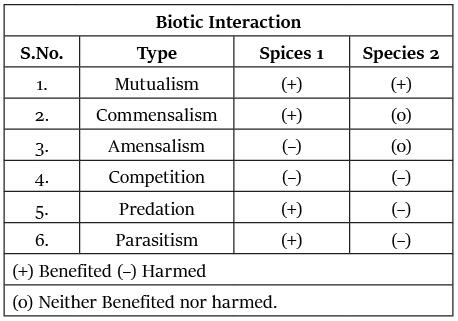
Types of biotic interaction
- Mutualism: both species benefit.
Example: in pollination mutualisms, the pollinator gets food (pollen, nectar), and the plant has its pollen transferred to other flowers for cross-fertilization (reproduction). - Commensalism: one species benefits, the other is unaffected.
Example: cow dung provides food and shelter to dung beetles. The beetles do not affect the cows. - Competition: the interaction harms both species.
Example: if two species eat the same food, and there isn't enough for both, both may have access to less food than they would if alone. They both suffer a shortage of food. - Predation and parasitism: one species benefits, the other is harmed.
Example: predation—one fish kills and eats parasitism: tick gains benefit by sucking blood; the host is harmed by losing blood. - Amensalism: One species is harmed, the other is unaffected.
Example: A large tree shades a small plant, retarding the growth of the small plant. The small plant does not affect the large tree. - Neutralism: There is no net benefit or harm to either species. Perhaps in some interspecific interactions, the costs and benefits experienced by each partner are the same so that they sum to zero. It is not clear how often this happens in nature. Neutralism is also sometimes described as the relationship between two species inhabiting the same space and using the same resources, but that does not affect each other. In this case, one could argue that they aren't interacting at all.
What Is Bio-Geo-Chemical Cycle?
- The living world depends upon the energy flow and the circulation of the nutrients that occurs through the ecosystem. Both influence the abundance of organisms, the metabolic rate at which they live, and the ecosystem's complexity.
- Energy flows through ecosystems enabling the organisms to perform various kinds of work, and this energy is ultimately lost as heat forever in terms of the system's usefulness. On the other hand, nutrients of food matter never get used up. We can recycle them again and again indefinitely.
Example: when we breathe, we may be inhaling several million atoms of elements that may have been inhaled by our ancestors or other organisms. - Carbon, hydrogen, oxygen, nitrogen, and phosphorus as elements and compounds makeup 97% of our bodies' mass and are more than 95% of all living organisms' mass.
- In addition to these about 15 to 25 other elements are needed for the survival and good health of plants and animals. These elements or mineral nutrients are always in circulation, moving from non-living to living and then back to the ecosystem's non-living components in a more or less circular fashion. This circular fashion is known as biogeochemical cycling (bio for a living; geo for atmosphere).
What is Nutrient Cycling?
- The nutrient cycle is a concept that describes how nutrients move from the physical environment to the living organisms and subsequently recycled back to the physical environment.
- This movement of nutrients from the environment into plants and animals and the environment is essential for life. It is the vital function of any region's ecology. In any particular environment, to maintain its organism in a sustained manner, the nutrient cycle must be balanced and stable.
- Nutrient cycling is typically studied in terms of specific nutrients, with each nutrient in an environment having its own particular pattern of cycling.
- Among the most important nutrient cycles are the carbon nutrient cycle and the nitrogen nutrient cycle. Both of these cycles make up an essential part of the overall soil nutrient cycle. Many other nutrient cycles are important in ecology, including a large number of trace mineral nutrient cycles.
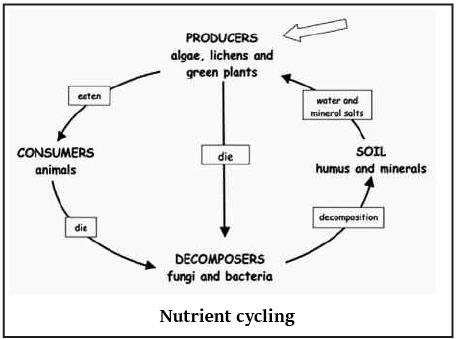
Types of Nutrient Cycle
- Based on the replacement period, a nutrient cycle is referred to as Perfect or Imperfect cycle.
- A perfect nutrient cycle is one in which nutrients are replaced as fast as they are utilized. Most gaseous cycles are generally considered as perfect cycles.
- In contrast, sedimentary cycles are considered relatively imperfect, as some nutrients are lost from the cycle and get locked into sediments and become unavailable for immediate cycling.
- Based on the reservoir's nature, there are two types of cycles: Gaseous and sedimentary cycle.
- Gaseous Cycle – where the reservoir is the atmosphere or the hydrosphere, and
- Sedimentary Cycle – where the reservoir is the earth's crust.
Gaseous Cycles
Let us first study some of the most important gaseous cycles: water, carbon and nitrogen.
(i) Water Cycle (Hydrologic)
- Water as an important ecological factor determines the structure and function of the ecosystem. Cycling of all other nutrients depends on water as it provides their transportation during the various steps. It acts as a solvent medium for their uptake of nutrients by organisms.
- The hydrologic cycle is the continuous circulation of water in the Earth-atmosphere system driven by solar energy. Water on our planet is stored in major reservoirs like atmosphere, oceans, lakes, rivers, soils, glaciers, snowfields, and groundwater. Water moves from one reservoir to another by the processes of evaporation, transpiration, condensation, precipitation, deposition, runoff, infiltration, and groundwater flow.
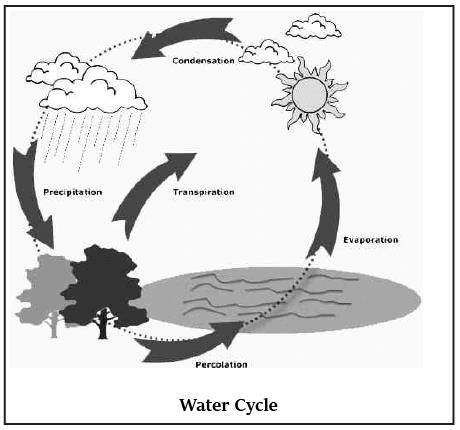
(ii) The Carbon Cycle
- Carbon is a minor constituent of the atmosphere as compared to oxygen and nitrogen. However, without carbon dioxide life could not exist, because it is vital for the production of carbohydrates through photosynthesis by plants. It is the element that anchors all organic substances from coal and oil to DNA (deoxyribonucleic acid: the compound that carries genetic information).
- Carbon is present in the atmosphere, mainly in the form of carbon dioxide (CO2). Carbon cycle involves a continuous exchange of carbon between the atmosphere and organisms. Carbon from the atmosphere moves to green plants by the process of photosynthesis, and then to animals. By process of respiration and decomposition of dead organic matter, it returns to the atmosphere. It is usually a short term cycle.
- Some carbon also enters a long term cycle. It accumulates as un-decomposed organic matter in the peaty layers of marshy soil or as insoluble carbonates in bottom sediments of aquatic systems which take a long time to be released. Such carbon can remain buried in deep oceans for millions of years till geological movement may lift these rocks above sea level. These rocks may be exposed to erosion, releasing their carbon dioxide, carbonates and bicarbonates into streams and rivers.
- Fossil fuels such as coals, oil and natural gas etc. are organic compounds buried before they could be decomposed and subsequently transformed by time and geological processes into fossil fuels. When they are burned, the carbon stored in them is released back into the atmosphere as carbon dioxide.
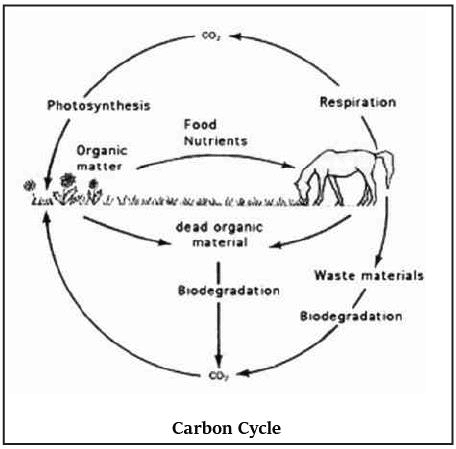
(iii) The Nitrogen Cycle
- Nitrogen is an essential constituent of protein and is a basic building block of all living tissue. It constitutes nearly 16% by weight of all the proteins.
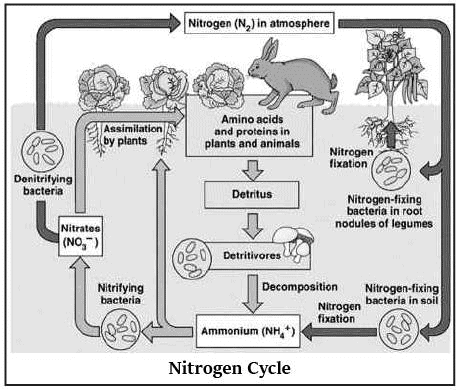
- There is an inexhaustible nitrogen supply in the atmosphere, but the elemental form cannot be used directly by most living organisms. Nitrogen needs to be 'fixed', converted to ammonia, nitrites or nitrates, before plants can take it up.
- Nitrogen fixation on earth is accomplished in three different ways:
(i) By microorganisms (bacteria and blue-green algae)
(ii) By man using industrial processes (fertilizer factories) and
(iii) To a limited extent by atmospheric phenomena such as thunder and lighting - The amount of Nitrogen fixed by man through the industrial process has far exceeded the Natural Cycle amount. As a result, Nitrogen has become a pollutant which can disrupt the balance of nitrogen. It may lead to Acid rain, Eutrophication and Harmful Algal Blooms.
- Certain microorganisms are capable of fixing atmospheric nitrogen into ammonium ions. These include free-living nitrifying bacteria (e.g. aerobic Azotobacter and anaerobic Clostridium) and symbiotic nitrifying bacteria living in association with leguminous plants and symbiotic bacteria living in non-leguminous root nodule plants (e.g. Rhizobium) as well as blue, green algae (e.g. Anabaena, Spirulina).
- Ammonium ions can be directly taken up as a source of nitrogen by some plants or oxidized to nitrites or nitrates by two groups of specialized bacteria: Nitrosomonas bacteria promote ammonia transformation into nitrite. Nitrite is then further transformed into nitrate by the bacteria Nitrobacter. The nitrates synthesized by bacteria in the soil are taken up by plants and converted into amino acids, which are the building blocks of proteins.
- These then go through higher trophic levels of the ecosystem. During excretion and upon the death of all organisms nitrogen is returned to the soil in ammonia. A certain quantity of soil nitrates, being highly soluble in water, is lost to the system by being transported away by surface runoff or groundwater.
- In the soil and oceans, there are special denitrifying bacteria (e.g. Pseudomonas), which convert the nitrates/nitrites to elemental nitrogen. This nitrogen escapes into the atmosphere, thus completing the cycle. The periodic thunderstorms convert the gaseous nitrogen in the atmosphere to ammonia and nitrates, eventually reaching the earth's surface through precipitation and then into the soil to be utilized by plants.
Sedimentary Cycle
Phosphorus, calcium and magnesium circulate utilizing the sedimentary cycle. The element involved in the sedimentary cycle normally does not cycle through the atmosphere but follows a basic pattern of flow through erosion, sedimentation, mountain building, volcanic activity and biological transport through the excreta of marine birds.
(i) Phosphorus Cycle
- Phosphorus plays a central role in aquatic ecosystems and water quality. Unlike carbon and nitrogen, which come primarily from the atmosphere, phosphorus occurs in large amounts as a mineral in phosphate rocks and enters the cycle from erosion and mining activities. This nutrient is considered the main cause of excessive growth of rooted and free-floating microscopic plants in lakes.
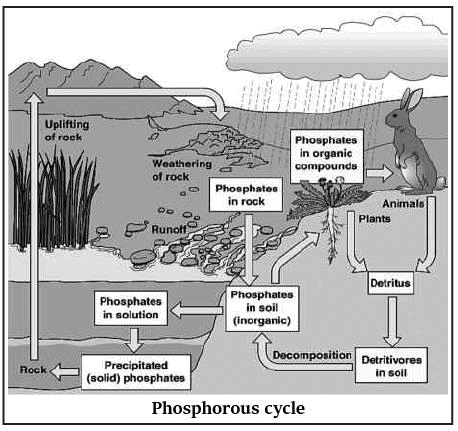
- The main storage for phosphorus is in the earth's crust. On land, phosphorus is usually found in the form of phosphates. By weathering and erosion, phosphates enter rivers and streams that transport them to the ocean.
- In the ocean, once the phosphorus accumulates on continental shelves in the form of insoluble deposits. After millions of years, the crustal plates rise from the seafloor and expose the phosphates on land. After more time, weathering will release them from rock, and the cycle's geochemical phase begins again.
(ii) Sulphur Cycle
- The sulphur reservoir is in the soil and sediments where it is locked in organic (coal, oil and peat) and inorganic deposits (pyrite rock and sulphur rock) in the form of sulphates, sulphides and organic sulphur. It is released by weathering rocks, erosional runoff and decomposition of organic matter and is carried to terrestrial and aquatic ecosystems in a salt solution.
- The sulphur cycle is mostly sedimentary except two of its compounds hydrogen sulphide (H2S), and sulphur dioxide (SO2) add a gaseous component to its normal sedimentary cycle. Sulphur enters the atmosphere from several sources like volcanic eruptions, combustion of fossil fuels, ocean surface, and gases released by decomposition.
- Atmospheric hydrogen sulphide also gets oxidized into sulphur dioxide. Atmospheric sulphur dioxide is carried back to the earth after being dissolved in rainwater as weak sulphuric acid.
- Whatever the source, sulphur in the form of sulphates is taken up by plants and incorporated through a series of metabolic processes into sulphur bearing amino acid incorporated in the proteins of autotroph tissues. It then passes through the grazing food chain.
- Sulphur bound in a living organism is carried back to the soil, to the bottom of ponds and lakes and seas through excretion and decomposition of dead organic material. The Bio-geochemical cycles discussed here are only a few of the many cycles present in the ecosystem. These cycles usually do not operate independently but interact with each other at some point or the other.
What Is Ecological Succession?
- Succession is a universal process of directional change in vegetation, on an ecological time scale. Succession occurs when communities replace one another due to large scale destruction, either natural or humanmade. This process continues - one community replacing another community until a stable, mature community develops.
- Succession is a progressive series of changes which leads to the establishment of a relatively stable climax community.

- The first plant to colonize an area is called the pioneer community. The final stage of succession is called the climax community. The stage leading to the climax community is called successional stages or seres.
- Succession is characterized by increased productivity, the shift of nutrients from' the reservoirs, increased diversity of organisms with increased niche development, and a gradual increase in the complexity of food webs.
➤ Primary Succession
- In primary succession on a terrestrial site, the new site is first colonized by a few hardy pioneer species, often microbes, lichens and mosses. The pioneers over a few generations alter the habitat conditions by their growth and development. These new conditions may be conducive to establishing additional organisms that may subsequently arrive at the site. The pioneers through their death any decay leave patches of organic matter in which small animals can live.
- The organic matter produced by these pioneer species produce organic acids during decomposition that dissolve and etch the substratum releasing nutrients to the substratum. Organic debris accumulates in pockets and crevices, providing soil in which seeds can become lodged and grow.
- As the community of organisms continues to develop, it becomes more diverse, and competition increases, but at the same time, new niche opportunities develop. The pioneer species disappear as the habitat conditions change and invasion of new species progresses, leading to the replacement of the preceding community.
➤ Secondary Succession
- Secondary succession occurs when plants recognize an area in which the climax community has been disturbed. Secondary succession is the sequential development of bi-otic communities after the complete or partial destruction of the existing community.
- A mature or intermediate community may be destroyed by natural events such as floods, droughts, fires, storms, or human interventions such as deforestation, agriculture, overgrazing, etc. This abandoned farmland is first invaded by hardy grasses species that can survive in bare, sun-baked soil. Tall grasses and herbaceous plants may soon join these grasses.
- These dominate the ecosystem for some years along with mice, rabbits, insects and seed-eating birds. Eventually, some trees come up in this area, seeds that may be brought by wind or animals. And over the years, a forest community develops. Thus abandoned farmland over a period becomes dominated by trees and is transformed into a forest. The differences between primary and secondary succession, the secondary succession starts on a well-developed soil already formed at the site. Thus secondary succession is relatively faster than primary succession, which may often require hundreds of years.
Autogenic and Allogenic Succession
When living inhabitants of that community itself bring about succession, the process is called autogenic succession, while change brought about by outside forces is known as allogenic succession.
➤ Autotrophic and Heterotrophic succession
- Succession in which the green plants are much greater is known as autotrophic succession; the ones in which the heterotrophs are greater in quantity is known as heterotrophic succession. Succession would occur faster in area existing in the middle of the large continent. This is because, here all propagules or seeds of plants belonging to the different seres would reach much faster, establish and ultimately result in the climax community.
|
95 videos|234 docs|52 tests
|
FAQs on Functions of an Ecosystem- 2 - Environment for UPSC CSE
| 1. What is the definition of biotic interaction? |  |
| 2. What is the bio-geo-chemical cycle? |  |
| 3. What is nutrient cycling? |  |
| 4. What are gaseous cycles? |  |
| 5. What is ecological succession? |  |
















